Recently, there has been an increasing number of protests against the publication science models adopted and ran in North America and Europe. These critics are fundamental to a shift of the paywall systems to a more collaborative and open framework, which will eventually take into account the reassessment and improvement of outdated publication methods, i.e., the peer-review. In this context, it is quite mandatory and useful to read two articles: this one and this other one
In my opinion, Early Career Scientists (ECRs) have a fundamental role in this game-change process. Most mid and late career scientists suffer from a strong inertia that, in turn, will demand too much energy to change their publishing habits (e.g. https://www.theatlantic.com/science/archive/2018/04/the-scientific-paper-is-obsolete/556676/) and will cause no significant selfish individual career improvements. ERCs are usually trapped in many system loopholes, but they often have the choice of targeting the journals to where they want to submit their research, and this makes lots of difference. Thinking out of the box by sharing your data and code is already a game changer, for better. Making use of journals that allow you to share your research in an open and transparent way is undoubtedly the right path to follow. My own experience has shown very positive results. I have been a user of the Open Science Framework (http://osf.io) to share my data and the EarthArXiv (https://eartharxiv.org/) to store my pre and postprints.
All this discussion on open science is especially interesting to me because back in 2009 (when I was doing my masters) I was still living in the “Brazilian scientific way of thinking” bubble. Let me be clearer, in Brazil the vast majority of publications are published in open (and free) access journals. In a nutshell, the Brazilian Government coordinates its own evaluation of scientific journals by attributing a higher impact to national-based journals than they have at an international scale. Although this system is not perfect, it makes a lot of sense since many scientific problems are dealt on a national level (sometimes only local significance) and not in English. Most of these journals are maintained by Universities, societies, and direct government-based funding initiatives. The most renowned example is the Scientific Electronic Library Online (SciELO, www.scielo.org). SciELO indexes, store and offer scientific manuscripts for over 20 years. This platform offers over 700 thousand peer-reviewed manuscripts for free, which have been cited over 15 million times. Given that is not a surprise that Brazil is considered a leader in open science (https://orcid.org/blog/2018/06/18/brazilian-leadership-open-research) and that it has help pushing Latin America in this practice (https://www.timeshighereducation.com/blog/why-open-access-publishing-growing-latin-america).
And it is not only in open access research that Brazil is considered a leader. Not long ago, there was Brazil was also a global leader in gender equality in science (https://www.forbes.com/sites/shannonsims/2017/03/08/surprising-new-study-brazil-now-a-global-leader-in-gender-equality-in-science/#56fc2216f448). These are great news, indeed. As a Brazilian national, I wonder what is the setup/decision tree that provided this outcome. Probably this is the only high profile permanent job (in terms of salary) in Brazil that is considered relatively gender balanced. Is anyone taking notes of these good examples and trying to replicating them in other countries? I’m not aware of it, but it would be good know that good practices are being followed or further improved.

















































